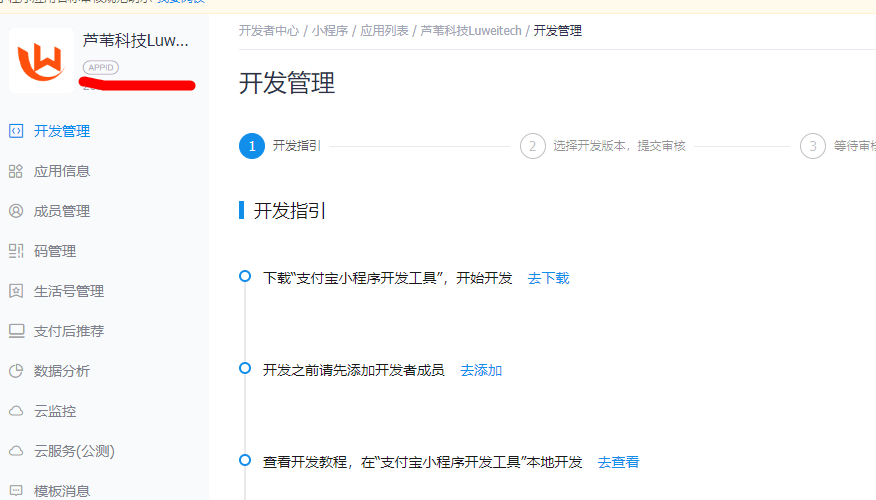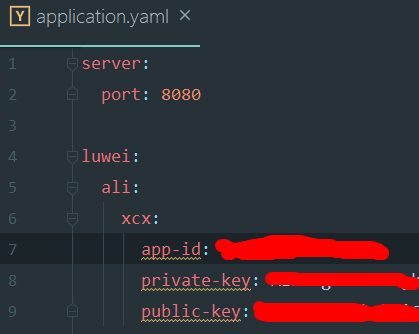IDEA支付寶小程式開發流程——授權登入
阿新 • • 發佈:2019-01-11
IDEA,支付寶小程式
grammar_cjkRuby: true
前置條件
-
獲取APPID
-
新增獲取會員資訊服務
詳情 > 開發管理 > 功能列表 > 新增功能 > 勾選 獲取會員資訊 > 確認,新增完成後的效果如下圖所示*PS:如果想獲取手機號和姓名等真實資訊,需要額外申請獲取 敏感資訊申請 流程
-
設定祕鑰
- 用阿里的金鑰生成工具生成公私鑰
- 上傳應用公鑰並獲取支付寶公鑰
- 登入開放平臺-開發者中心,選擇小程式,找到對應的小程式,點選【檢視】>【設定】> 【開發設定】 >【介面加簽方式】 > 【設定應用公鑰】 > 【設定應用公鑰】 > 把簽名驗籤工具裡“公鑰”的內容複製到此處,點選“儲存”完成金鑰設定
儲存成功後頁面變成下圖所示
公鑰用於驗籤使用
伺服器端
-
在專案的pom.xml中新增服務端SDK
<dependency> <groupId>com.alipay.sdk</groupId> <artifactId>alipay-sdk-java</artifactId> <version>3.4.49.ALL</version> </dependency> -
在application.yaml檔案中新增appid、公鑰、私鑰的配置
tips: 公鑰不是工具生成的公鑰,而是【公鑰設定成功頁面]裡】點選檢視支付寶公鑰裡獲取的公鑰
-
讀取配置檔案工具類AliXcxProperty.java
package com.example.demo.properties; import lombok.Data; import org.springframework.boot.context.properties.ConfigurationProperties; import org.springframework.stereotype.Component; /** * @Description * @Author LW-mochengdong * @Date 2018/12/22 11:42 **/ @Data @Component @ConfigurationProperties(prefix = "luwei.ali.xcx") public class AliXcxProperty { private String serverUrl; private String appId; private String privateKey; private String publicKey; } -
IndexController.java的程式碼
@GetMapping("/auth") public AlipayUserInfoShareResponse auth(@RequestParam String authcode){ return indexService.auth(authcode); } -
IndexService.java
package com.example.demo.service; import com.alibaba.fastjson.JSONObject; import com.alipay.api.AlipayApiException; import com.alipay.api.AlipayClient; import com.alipay.api.DefaultAlipayClient; import com.alipay.api.request.AlipaySystemOauthTokenRequest; import com.alipay.api.request.AlipayUserInfoShareRequest; import com.alipay.api.response.AlipaySystemOauthTokenResponse; import com.alipay.api.response.AlipayUserInfoShareResponse; import com.example.demo.properties.AliXcxProperty; import lombok.extern.slf4j.Slf4j; import org.springframework.stereotype.Service; import javax.annotation.Resource; /** * @Description * @Author LW-mochengdong * @Date 2018/12/22 11:38 **/ @Slf4j @Service public class IndexService { @Resource private AliXcxProperty aliXcxProperty; public AlipayUserInfoShareResponse auth(String authcode) { AlipayClient alipayClient = new DefaultAlipayClient(aliXcxProperty.getServerUrl(), aliXcxProperty.getAppId(), aliXcxProperty.getPrivateKey(), "JSON", "utf-8", aliXcxProperty.getPublicKey(), "RSA2"); //獲取uid&token AlipaySystemOauthTokenRequest request = new AlipaySystemOauthTokenRequest(); request.setGrantType("authorization_code");//值為authorization_code時,代表用code換取;值為refresh_token時,代表用refresh_token換取 request.setCode(authcode); try { AlipaySystemOauthTokenResponse response = alipayClient.execute(request); if (response.isSuccess()) { log.info("auth success [{}]", JSONObject.toJSONString(response)); AlipayUserInfoShareRequest alipayUserInfoShareRequest = new AlipayUserInfoShareRequest(); AlipayUserInfoShareResponse alipayUserInfoShareResponse = alipayClient.execute(alipayUserInfoShareRequest, response.getAccessToken()); if (alipayUserInfoShareResponse.isSuccess()) { log.info("AlipayUserInfoShareResponse success [{}]", JSONObject.toJSONString(alipayUserInfoShareResponse)); } else { log.info("AlipayUserInfoShareResponse fail [{}]", JSONObject.toJSONString(alipayUserInfoShareResponse)); } return alipayUserInfoShareResponse; } else { log.info("auth fail [{}]", JSONObject.toJSONString(response)); } } catch (AlipayApiException e) { log.error("auth exception", e); } return null; } }
以上,伺服器端的授權登入工作完畢,釋出即可!
客戶端
-
index.axml檔案
<view> {{index}} <button onTap="index"> 首頁 </button> <button onTap="getAuthCode"> 授權 </button> </view> -
index.js檔案
getAuthCode(){ my.getAuthCode({ scopes: 'auth_user', // 主動授權(彈框):auth_user,靜默授權(不彈框):auth_base success: (res) => { if (res.authCode) { // 認證成功 // 呼叫自己的服務端介面,讓服務端進行後端的授權認證,並且種session,需要解決跨域問題 my.httpRequest({ url: 'https://app2120230256test.mapp-test.xyz/auth', // 該url是自己的服務地址,實現的功能是服務端拿到authcode去開放平臺進行token驗證 data: { authcode: res.authCode }, success: () => { // 授權成功並且伺服器端登入成功 }, fail: () => { // 根據自己的業務場景來進行錯誤處理 }, }); } }, }); }-
儲存用真機掃碼測試
-
-
點選 授權 檢視控制檯network檢視的資料如下
以上說明整個授權過程成功!
-
伺服器控制檯的log也證實了這點
開啟日誌流程
- 我的小程式 > 檢視 > 雲服務(公測) > 環境資源 > 更多 > 開啟遠端日誌服務
下次部署專案時即可生效,不記得伺服器密碼的可以重置伺服器密碼,重置後需要重啟伺服器才能生效,日誌的路徑為/home/admin/logs
至此,支付寶小程式的授權登入流程已完成,感謝各位大神的觀看、評價、校正。PS:下一篇將實現授支付功能!
成東
廣州蘆葦科技Java開發團隊
蘆葦科技-廣州專業網際網路軟體服務公司
抓住每一處細節 ,創造每一個美好
關注我們的公眾號,瞭解更多
想和我們一起奮鬥嗎?lagou搜尋“ 蘆葦科技 ”或者投放簡歷到 [email protected] 加入我們吧
關注我們,你的評論和點贊對我們最大的支援










